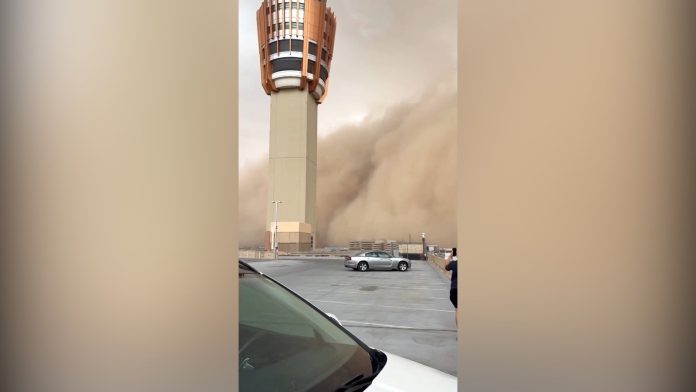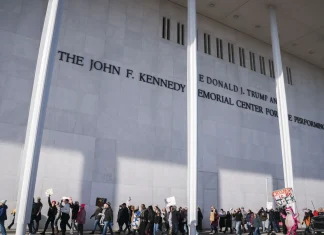When the Desert Roared: Arizona’s Haboob Brings Sky and Earth to a Standstill
Imagine standing on the edge of the Sonoran Desert, with the sun beating down, when suddenly the horizon darkens. A monstrous wall of swirling dust rushes toward you, like a living, breathing beast. This was the reality for residents and travelers in Arizona last week, when a colossal haboob—an intense dust storm—unleashed its power, grounding hundreds of flights and plunging communities into a momentary chaos.
Flight Plans Grounded as the Dust Takes Over
Phoenix’s Sky Harbor International Airport, typically bustling with relentless energy, came to a halt. More than 200 departure flights were delayed, stranded inside the airport’s concourses as the Federal Aviation Administration (FAA) issued a ground stop for about an hour. Pilots and passengers exchanged anxious glances, their journeys paused to the ominous drum of nature’s might.
“We see these weather events and we have to act quickly to ensure safety,” explained Lisa Moreno, a spokesperson for Sky Harbor Airport. “Visibility drops dramatically with a haboob, making flying impossible. It’s a stark reminder of how much we rely on clear skies.”
Indeed, the storm’s timing was brutal. As summer monsoons sweep through the Southwest, arid conditions set the stage for these natural dust tempests. The National Weather Service aptly named this one a “haboob,” a term borrowed from Arabic to describe powerful dust storms commonly seen in desert regions worldwide.
Understanding the Haboob: Nature’s Dusty Fury
Haboobs aren’t your everyday wind gusts. They’re born from thunderstorm downdrafts—rapidly descending air currents that slam into the parched desert surface. This explosive downward push scoops up fine, loose sand and dust. The result? A towering, thick cloud of dust several miles high, rolling outward like a sand tsunami.
Dr. Ahmed Khalil, a climatologist specializing in desert weather patterns, describes it vividly: “It’s like the desert itself is exhaling. The storm’s leading edge forms a wall that can stretch over 100 miles, blocking out the sun and reducing visibility to near zero within minutes.”
These storms can travel surprisingly far, sometimes even crossing state lines. On this occasion, the dust didn’t merely settle over Arizona; it roared into Nevada’s famous Black Rock Desert.
Burning Man Wrestles the Winds
The eerie dust shroud came at a particularly challenging moment for those attending the Burning Man festival—a sprawling week-long gathering that thrives on open desert space and communal creativity. Footage from the festival encapsulated the struggle: masked festival-goers clinging to tent poles, their faces swathed in scarves to fend off the gritty air, hammering stakes into the desert floor as fierce winds whipped around them.
“It’s like the desert is reminding us who’s boss,” quipped Sarah Jenkins, who has attended Burning Man for five years. “You can’t just build your little oasis here without respecting the elements.”
Organizers issued warnings, urging attendees to secure their campsites and be prepared for potential evacuations. Despite the disruption, the community spirit prevailed as neighbors pitched in to help each other weather the storm.
Tangled in the Dust: Life on the Ground
The haboob’s impact rippled through daily life far beyond the airport or festival grounds. Roads turned treacherous as traffic signals blinked out and trees, weakened by the fierce winds, toppled onto power lines. Approximately 5,700 residents experienced power outages—a blackout that felt like a return to a more elemental era, where technology bowed to nature’s whims.
Local police were quick to respond, setting up detours and sharing crucial updates on social media. “People need to slow down and be patient,” urged Officer Miguel Torres of Phoenix PD. “Visibility can drop so low that you might not see the car in front of you.”
Driving during a haboob requires more than just caution; it demands respect. Many residents, from ranchers to city dwellers, have learned to pause and wait out these events—a lesson handed down by generations who know the desert’s temperament well.
Reflections on Dust and Resilience
There’s something humbling about being caught in a haboob. In a world speeding ahead with relentless technology and endless connectivity, these storms enforce a pause. They remind us of our place within a larger ecosystem, vulnerable and yet resilient.
Arizona, despite its sprawling cities and high-tech industries, remains a land deeply tied to the rhythms of nature. The summer monsoon season is both a bringer of life-giving water and a harbinger of dramatic forces like the haboob. It’s a cyclical dance between the desert and its inhabitants, a negotiation of survival and adaptation.
“People sometimes see the desert as harsh and unforgiving,” says Dr. Khalil, “but it’s a dynamic environment. Every dust storm, every rainstorm, shapes not just the landscape but the culture of these places. We learn to expect the unexpected.”
What Can We Learn from the Haboob?
As global climate patterns shift and the environment faces growing pressures, events like this haboob invite us to consider our relationship with nature and each other. How do we prepare for the sudden? How do we build communities that are both secure and flexible? In the Southwest and beyond, these questions grow ever more urgent.
For travelers who found themselves stranded at Sky Harbor and festival-goers clinging to tents amid dusty gales, the haboob was an unwelcome visitor. Yet beneath the inconvenience lies a deep, elemental reminder: we are part of a larger, powerful world—one that commands respect, patience, and awe.
So next time you see an ominous cloud edging across the desert horizon, ask yourself: are you ready for the earth to speak back?
Key Takeaways:
- Arizona’s recent haboob grounded over 200 flights and disrupted daily life.
- Haboobs are dust storms caused by thunderstorm downdrafts lifting desert sand.
- These storms can reduce visibility drastically, impacting transportation and safety.
- Burning Man festival attendees faced the challenge head-on, embodying community resilience.
- Approximately 5,700 residents experienced power outages due to the storm’s fierce winds.










